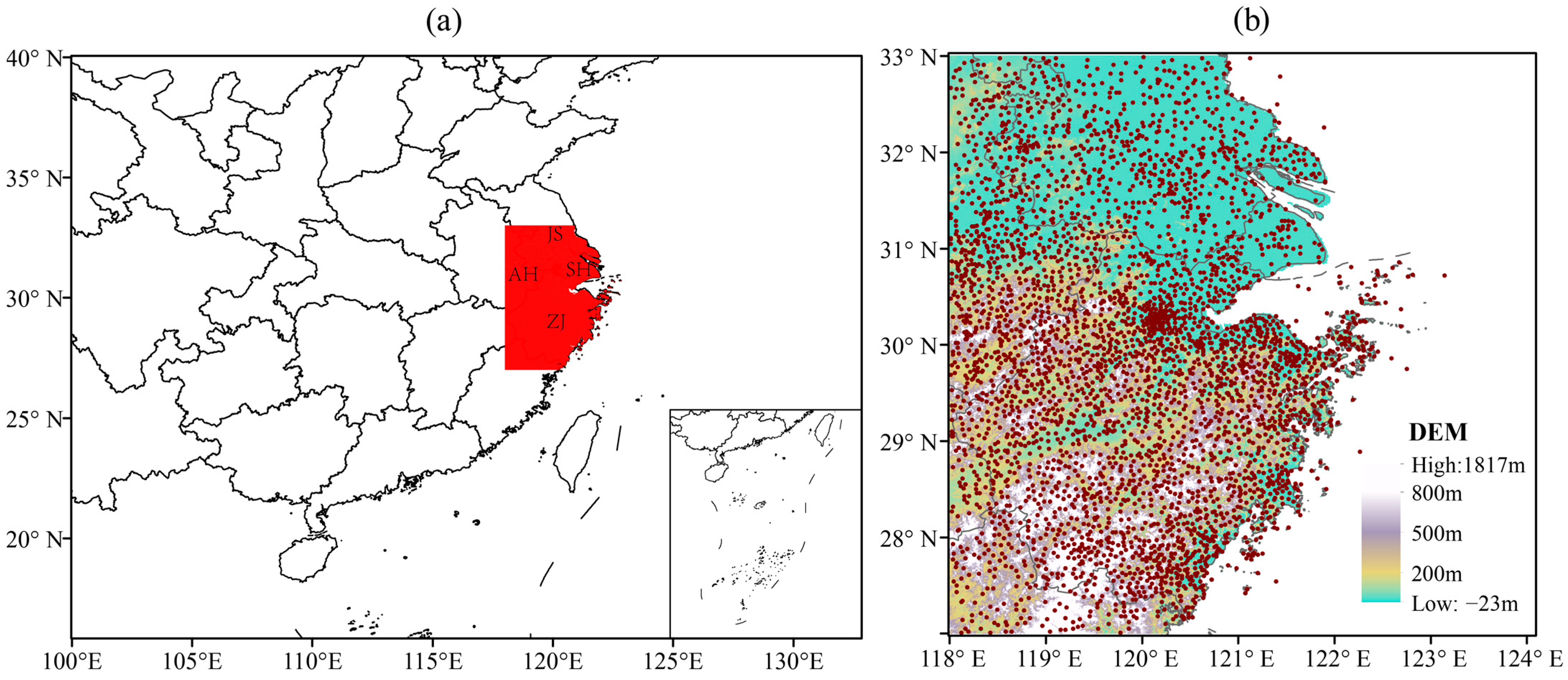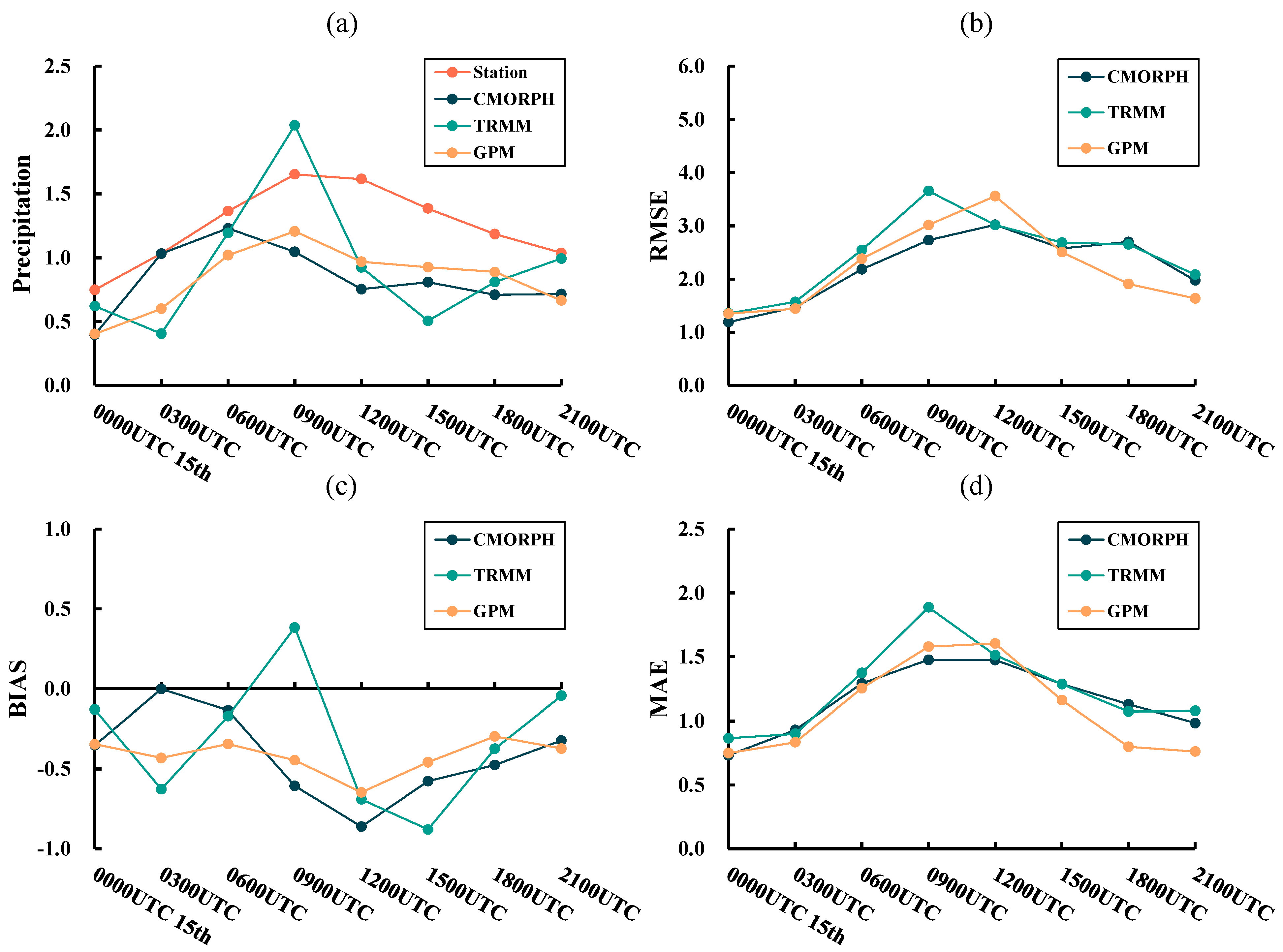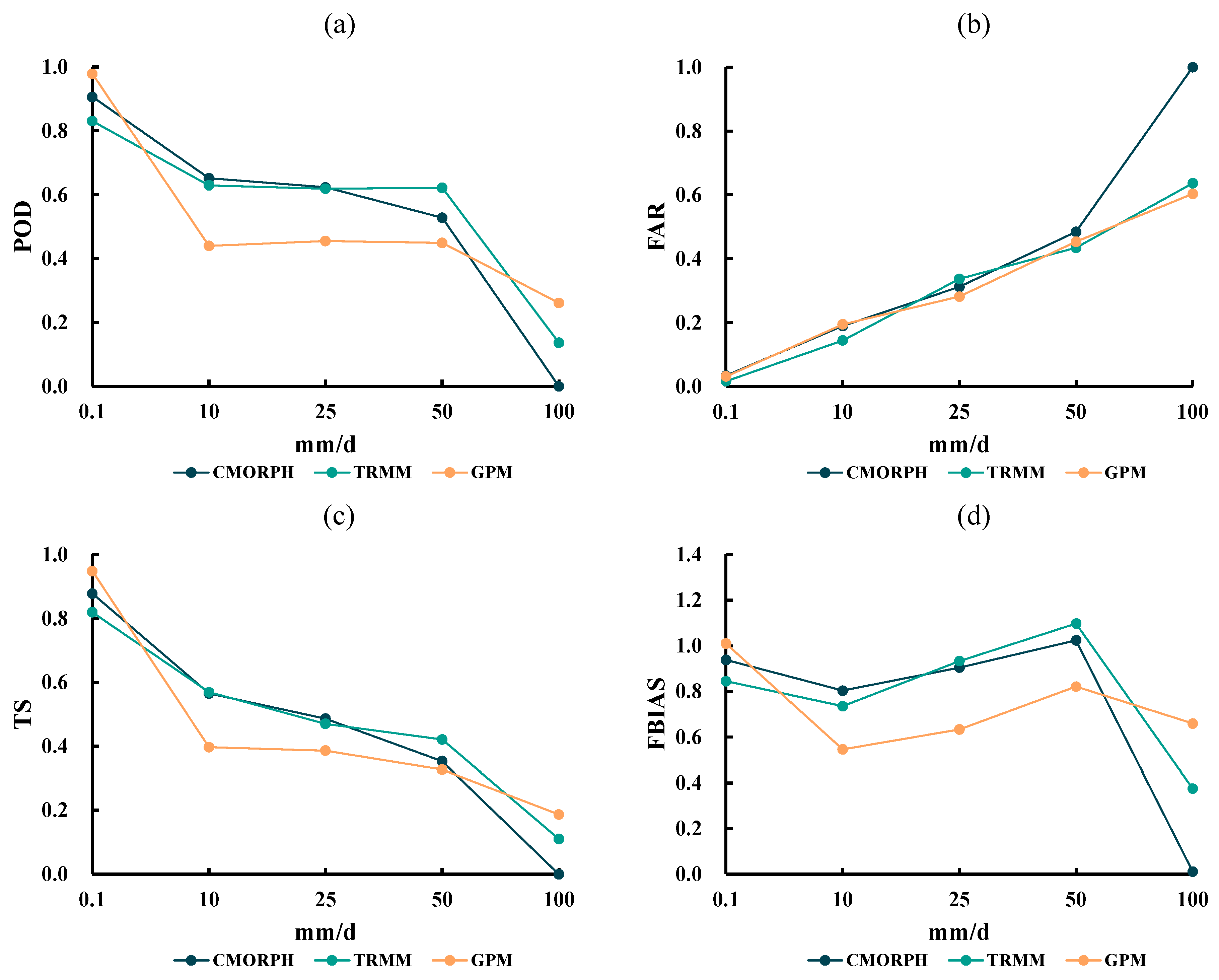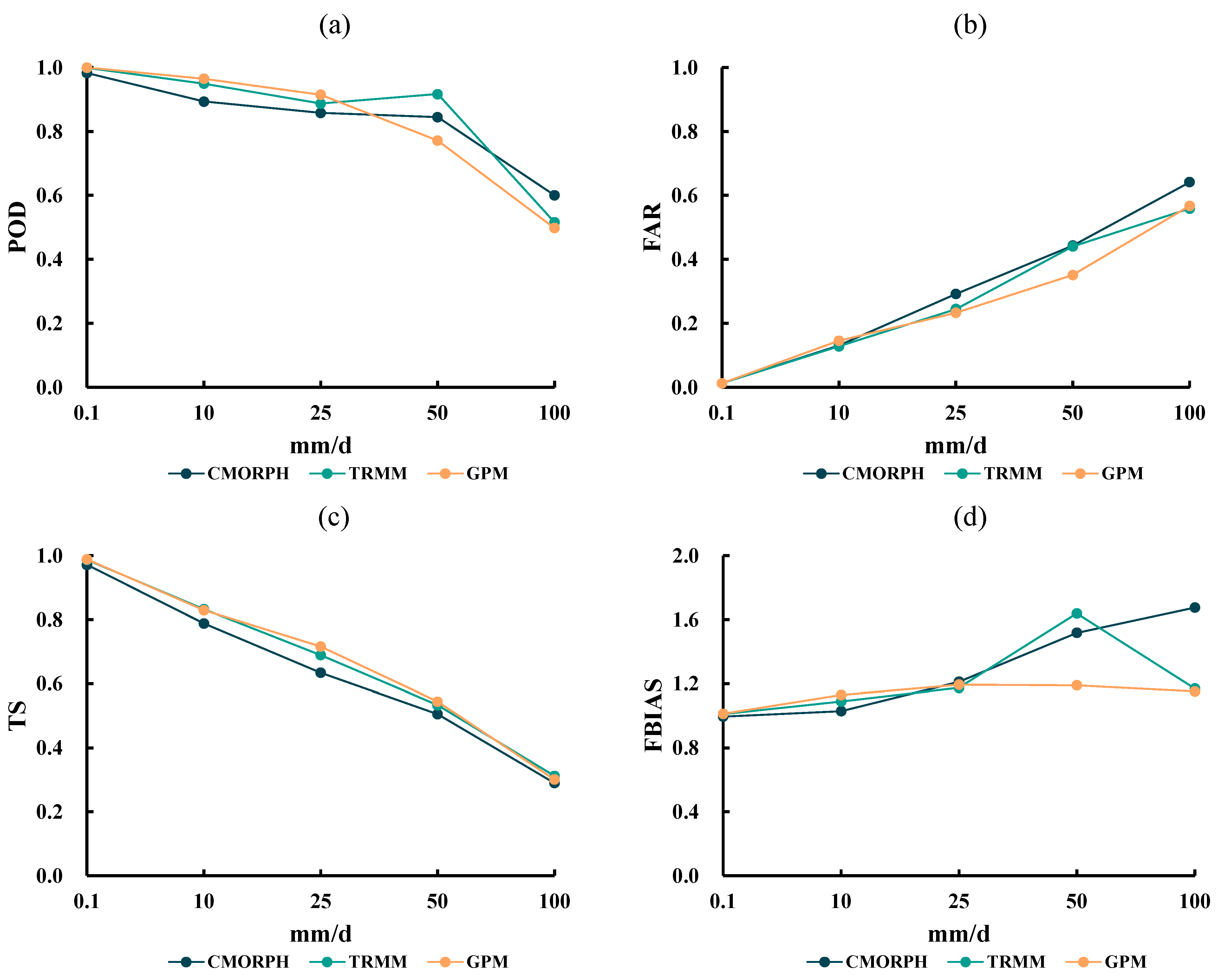Assessment of Satellite Products in Estimating Tropical Cyclone Remote Precipitation over the Yangtze River Delta Region
Abstract
1. Introduction
2. Study Area and Data
2.1. Study Area
2.2. Data
3. Methodology
4. Results
4.1. Spatial Distribution Characteristics
4.2. Temporal Distribution Characteristics
4.3. Graduated Precipitation Accuracy Evaluation
5. Discussion
5.1. Monitoring Capabilities
5.2. Limitations and Challenges
6. Conclusions
Author Contributions
Funding
Institutional Review Board Statement
Informed Consent Statement
Data Availability Statement
Conflicts of Interest
References
- Elahi, E.; Li, G.; Han, X.; Zhu, W.; Liu, Y.; Cheng, A.; Yang, Y. Decoupling Livestock and Poultry Pollution Emissions from Industrial Development: A Step towards Reducing Environmental Emissions. J. Environ. Manag. 2024, 350, 119654. [Google Scholar] [CrossRef] [PubMed]
- Yin, S.; Liu, L.; Mahmood, T. New Trends in Sustainable Development for Industry 5.0: Digital Green Innovation Economy. Green Low-Carbon Econ. 2023, 1–8. [Google Scholar] [CrossRef]
- Abbas, A.; Waseem, M.; Ahmad, R.; Khan, K.A.; Zhao, C.; Zhu, J. Sensitivity Analysis of Greenhouse Gas Emissions at Farm Level: Case Study of Grain and Cash Crops. Environ. Sci. Pollut. Res. 2022, 29, 82559–82573. [Google Scholar] [CrossRef] [PubMed]
- Shu, Z.; Li, W.; Zhang, J.; Jin, J.; Xue, Q.; Wang, Y.; Wang, G. Historical Changes and Future Trends of Extreme Precipitation and High Temperature in China. Strateg. Study Chin. Acad. Eng. 2022, 24, 116–125. [Google Scholar] [CrossRef]
- Chen, L.S. The Evolution on Research and Operational Forecasting Techniques of Tropical Cyclones. J. Appl. Meteorol. Sci. 2006, 17, 672–681. [Google Scholar] [CrossRef]
- Chen, L.S. Study and Forecast on Landfall Tropicalcyclone Heavy Rainfall. In Proceedings of the 14th Proseminar on Tropical Cyclone, Shanghai, China, 6−9 November 2021; pp. 3–7. Available online: https://d.wanfangdata.com.cn/conference/7187768 (accessed on 15 March 2024). (In Chinese).
- Galarneau, T.J.; Bosart, L.F.; Schumacher, R.S. Predecessor Rain Events Ahead of Tropical Cyclones. Mon. Weather Rev. 2010, 138, 3272–3297. [Google Scholar] [CrossRef]
- Cong, C.H.; Chen, L.S.; Lei, X.T.; Li, Y. A study on the mechanism of the tropical cyclone remote precipitation. Acta Meteorol. Sin. 2012, 70, 717–727, (In Chinese with English Abstract). [Google Scholar] [CrossRef]
- Jiang, F.R.; Jiang, B. Study on impacts of typhoon on China and its characteristics. Yangtze River 2014, 45, 85–89. [Google Scholar] [CrossRef]
- Xu, H.; Li, X.; Yin, J.; Zhang, D. Predecessor Rain Events in the Yangtze River Delta Region Associated with South China Sea and Northwest Pacific Ocean (SCS-WNPO) Tropical Cyclones. Adv. Atmos. Sci. 2023, 40, 1021–1042. [Google Scholar] [CrossRef]
- Chen, S.Q.; Li, Y.; Fan, Y.M.; Xu, Z.Y.; Li, F. Analysis of Long-Distance Heavy Rainfall Caused by Typhoon Mangosteen. Chin. J. Atmos. Sci. 2021, 45, 573–587. [Google Scholar] [CrossRef]
- Castro, L.M.; Gironás, J.; Fernández, B. Spatial Estimation of Daily Precipitation in Regions with Complex Relief and Scarce Data Using Terrain Orientation. J. Hydrol. 2014, 517, 481–492. [Google Scholar] [CrossRef]
- Cheng, L.; Shen, R.P.; Shi, C.X.; Bai, L.; Yang, Y.H. Evaluation and Verification of CMORPH and TRMM 3B42 Precipiation Estimation Products. Metorol. Mon. 2014, 40, 1372–1379. [Google Scholar] [CrossRef]
- Xiao, L.S.; Zhang, A.S.; Min, C.; Chen, S.; Sheng, C. Evaluation of GPM satellite-based precipitation estimates during three tropical-related extreme rainfall events. Plateau Meteorol. 2019, 38, 993–1003. [Google Scholar] [CrossRef]
- Li, Q.L.; Zhang, W.C.; Yi, L.; Liu, J.P.; Chen, H. Accuracy evaluation and comparison of GPM and TRMM precipitation product over Mainland China. Adv. Water Sci. 2018, 19, 303–313. [Google Scholar] [CrossRef]
- Wang, D.D.; Fang, Y.Y.; Qian, Y.Z.; Shen, H.Y.; Chen, S. Evaluation on application of GPM satellites during typhoon-precipitation process. Water Resour. Hydropower Eng. 2022, 54, 1–17. [Google Scholar] [CrossRef]
- Liu, S.N.; Wang, J.; Wang, H.J. Analysis of the Monitoring Ability of High-Resolution Satellites for the “21·7” Heavy Rain in Henan. Acta Meteorol. Sin. 2022, 80, 765–776. [Google Scholar] [CrossRef]
- Zhang, C.; Li, Z.; Xiao, J.; Zhou, L.; Fang, H.; Zhang, L.; Zhang, H. Spatio-temporal Characteristics of Thermal Comfort in the Yangtze River Delta. Clim. Environ. Res. 2022, 27, 669–678. [Google Scholar] [CrossRef]
- Shouli, X.; Qingyun, Z.; Shuqing, S. Anomalous Midsummer Rainfall in Yangtze River-Huaihe River Valleys and Its Association with the East Asia Westerly Jet. Adv. Atmos. Sci. 2011, 28, 387–397. [Google Scholar] [CrossRef]
- Liu, S.J.; Cai, D.X.; Han, J.; Gan, Y.X. Progress of the Satellite Remote Sensing Retrieval of Precipitation. Adv. Meteorol. Sci. Technol. 2021, 11, 28–33. [Google Scholar]
- Ebert, E.E.; Janowiak, J.E.; Kidd, C. Comparison of Near-Real-Time Precipitation Estimates from Satellite Observations and Numerical Models. Bull. Am. Meteor. Soc. 2007, 88, 47–64. [Google Scholar] [CrossRef]
- Chen, S.; Hong, Y.; Cao, Q.; Kirstetter, P.-E.; Gourley, J.J.; Qi, Y.C.; Zhang, J.; Howard, K.; Hu, J.J.; Wang, J. Performance Evaluation of Radar and Satellite Rainfalls for Typhoon Morakot over Taiwan: Are Remote-Sensing Products Ready for Gauge Denial Scenario of Extreme Events? J. Hydrol. 2013, 506, 4–13. [Google Scholar] [CrossRef]
- Liu, D.L.; Chen, C. Preliminary Application and Evaluation of Optimal Threat Score Method in Hourly Precipitation Forecast. J. Trop. Meteorol. 2022, 38, 611–620. [Google Scholar] [CrossRef]
- Ma, S.J.; Chen, C.H.; He, H.R.; Li, X.; Li, Y. Experiment and Verification of the Convective-Scale Ensemble Forecast Based on BGM. Plateau Meteorol. 2018, 37, 495–504. [Google Scholar]
- Chen, H.Q.; Lu, D.K.; Zhou, Z.H.; Zhu, Z.W.; Ren, Y.J.; Yong, B. An overview of assessments on global precipitation measurement (GPM) precipitation products. Water Resour. Prot. 2019, 35, 27–34. [Google Scholar] [CrossRef]
- Jin, X.L.; Shao, H.; Zhang, C.; Yan, Y. The Applicability Evaluation of Three Satellite Products in Tianshan Mountains. J. Nat. Resour. 2016, 31, 2074–2085. [Google Scholar] [CrossRef]
- Tang, G.Q.; Wan, W.; Zeng, Z.Y.; Guo, X.L.; Li, N.; Long, D.; Hong, Y. An Overview of the Global Precipitation Measurement (GPM) Mission and Its Latest Development. Remote Sens. Technol. Appl. 2015, 30, 607–615. [Google Scholar] [CrossRef]
- Ji, H.; Peng, D.; Gu, Y.; Liang, Y.; Luo, X. Evaluation of Multiple Satellite Precipitation Products and Their Potential Utilities in the Yarlung Zangbo River Basin. Sci. Rep. 2022, 12, 13334. [Google Scholar] [CrossRef] [PubMed]
- Benkirane, M.; Laftouhi, N.-E.; Khabba, S.; El Mansouri, B. Multiscale Assessment of TRMM (3B42 V7) and GPM (IMERG V5) Satellite Precipitation Products over a Mediterranean Mountainous Watershed with Sparse Rain Gauges in the Moroccan High Atlas (Case Study of Zat Basin). Hydrol. Earth Syst. Sci. Discuss. 2021, 1–18. [Google Scholar] [CrossRef]
- Yan, G.; Liu, Y.; Chen, X. Evaluating Satellite-Based Precipitation Products in Monitoring Drought Events in Southwest China. Int. J. Remote Sens. 2018, 39, 3186–3214. [Google Scholar] [CrossRef]
- Zhang, Y.; Wu, C.; Yeh, P.J.-F.; Li, J.; Hu, B.X.; Feng, P.; Lei, Y. Evaluation of Multi-Satellite Precipitation Products in Estimating Precipitation Extremes over Mainland China at Annual, Seasonal and Monthly Scales. Atmos. Res. 2022, 279, 106387. [Google Scholar] [CrossRef]
- Yu, L.; Leng, G.; Python, A. A Comprehensive Validation for GPM IMERG Precipitation Products to Detect Extremes and Drought over Mainland China. Weather Clim. Extrem. 2022, 36, 100458. [Google Scholar] [CrossRef]
- Tang, G.; Ma, Y.; Long, D.; Zhong, L.; Hong, Y. Evaluation of GPM Day-1 IMERG and TMPA Version-7 Legacy Products over Mainland China at Multiple Spatiotemporal Scales. J. Hydrol. 2016, 533, 152–167. [Google Scholar] [CrossRef]
- Huang, C.; Zhang, S.; Dong, L.; Wang, Z.; Li, L.; Cui, L. Spatial and Temporal Variabilities of Rainstorms over China under Climate Change. J. Geogr. Sci. 2021, 31, 479–496. [Google Scholar] [CrossRef]
- Smith, T.M.; Arkin, P.A.; Bates, J.J.; Huffman, G.J. Estimating Bias of Satellite-Based Precipitation Estimates. J. Hydrometeorol. 2006, 7, 841–856. [Google Scholar] [CrossRef]
- Zhu, H.Q.; Chen, S.; Li, X.Y.; Li, Z. Assessment on error of GPM satellite-based precipitation products during ‘7.21’extreme rainstorm in Henan. Water Resour. Hydropower Eng. 2022, 53, 1–13. [Google Scholar] [CrossRef]
- Zhou, Z.; Guo, B.; Xing, W.; Zhou, J.; Xu, F.; Xu, Y. Comprehensive Evaluation of Latest GPM Era IMERG and GSMaP Precipitation Products over Mainland China. Atmos. Res. 2020, 246, 105132. [Google Scholar] [CrossRef]
- Jiang, S.; Ren, L.; Hong, Y.; Yong, B.; Yang, X.; Yuan, F.; Ma, M. Comprehensive Evaluation of Multi-Satellite Precipitation Products with a Dense Rain Gauge Network and Optimally Merging Their Simulated Hydrological Flows Using the Bayesian Model Averaging Method. J. Hydrol. 2012, 452–453, 213–225. [Google Scholar] [CrossRef]
- Yu, Z.; Yu, H.; Chen, P.; Qian, C.; Yue, C. Verification of Tropical Cyclone–Related Satellite Precipitation Estimates in Mainland China. J. Appl. Meteorol. Climatol. 2009, 48, 2227–2241. [Google Scholar] [CrossRef]
- Wang, X.; Ding, Y.; Zhao, C.; Wang, J. Similarities and Improvements of GPM IMERG upon TRMM 3B42 Precipitation Product under Complex Topographic and Climatic Conditions over Hexi Region, Northeastern Tibetan Plateau. Atmos. Res. 2019, 218, 347–363. [Google Scholar] [CrossRef]
- Xu, R.; Tian, F.; Yang, L.; Hu, H.; Lu, H.; Hou, A. Ground Validation of GPM IMERG and TRMM 3B42V7 Rainfall Products over Southern Tibetan Plateau Based on a High-Density Rain Gauge Network. J. Geophys. Res. Atmos. 2017, 122, 910–924. [Google Scholar] [CrossRef]









Disclaimer/Publisher’s Note: The statements, opinions and data contained in all publications are solely those of the individual author(s) and contributor(s) and not of MDPI and/or the editor(s). MDPI and/or the editor(s) disclaim responsibility for any injury to people or property resulting from any ideas, methods, instructions or products referred to in the content. |
© 2024 by the authors. Licensee MDPI, Basel, Switzerland. This article is an open access article distributed under the terms and conditions of the Creative Commons Attribution (CC BY) license (https://creativecommons.org/licenses/by/4.0/).
Share and Cite
Wu, X.; Liu, Y.; Liu, S.; Jin, Y.; Xu, H. Assessment of Satellite Products in Estimating Tropical Cyclone Remote Precipitation over the Yangtze River Delta Region. Atmosphere 2024, 15, 667. https://doi.org/10.3390/atmos15060667
Wu X, Liu Y, Liu S, Jin Y, Xu H. Assessment of Satellite Products in Estimating Tropical Cyclone Remote Precipitation over the Yangtze River Delta Region. Atmosphere. 2024; 15(6):667. https://doi.org/10.3390/atmos15060667
Chicago/Turabian StyleWu, Xinyue, Yebing Liu, Shulan Liu, Yubing Jin, and Huiyan Xu. 2024. "Assessment of Satellite Products in Estimating Tropical Cyclone Remote Precipitation over the Yangtze River Delta Region" Atmosphere 15, no. 6: 667. https://doi.org/10.3390/atmos15060667
APA StyleWu, X., Liu, Y., Liu, S., Jin, Y., & Xu, H. (2024). Assessment of Satellite Products in Estimating Tropical Cyclone Remote Precipitation over the Yangtze River Delta Region. Atmosphere, 15(6), 667. https://doi.org/10.3390/atmos15060667






